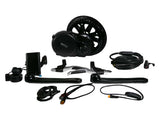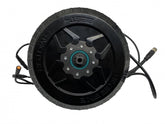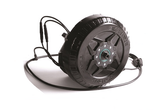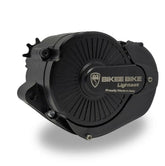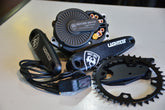FAQ
The legal limit for an electric bike to still be categorised as a bicycle in Australia is 200w, or 250w* if operated by pedelec rather than throttle. Our 250w kits fall inside the Australian legal limit, presuming you don’t fit the throttle (which is included as a user option).
A 250w motor is meant to be engaged by pedelec only (once over 7km/h). You are allowed to run a 200w motor if engaged by a throttle, and essentially these are the same motors with a bit less current running through the controller. See details of the Victorian e-bike laws here.
Our 500w* and higher kits are sold for off-road use only.
*On 24 February 2023, the NSW Government legislated to allow motors up to a “maximum continued rated power of 500W” with pedal assist for use in permitted public places. All other states and territories retain the 250W limit. Read our article here.
If you leave it turned off or on lowest levels of pedelec, you can get “up to” fifty million miles out of it 😉
That kind of measure, of what is POSSIBLE (but not PROBABLE), is
useless to most people, because you really want to know how far you are CERTAIN to get.
That’s why REV-Bikes work on REALISTIC MINIMUMS for our range stats, which presume you are not assisting much, and are doing lots of hills and take-offs (which are the things that drain the battery the fastest). If you are being more conservative with your use, you can potential double these figures, or even go beyond that.
Generally speaking, you should get a minimum anywhere from 40 to 100kms per charge with a 250w motor, depending on the battery you choose, and how you ride. Our 500w motors will give you range of 25-60kms. The 1000w motors about 20-40kms.
Using the lower levels of pedelec
assistance (while pedalling) is the most efficient way to use your e-bike, for the longest range. You can turn the power up for hills as
required, but more power uses the battery faster.
YES! REV-Bikes are not trying to be the cheapest, we strive to be the best!
Our reputation and success depend on you having a positive experience. As a result, we are always undertaking R&D to bring you the best products we can.
REV personally visit our manufacturers factories, and test all of our components (to their limits!) before offering them to our customers for sale. We are confident that our motors can
comfortably withstand normal riding conditions, and are suitably tough when challenged with Australian terrain.
We have our batteries packed with proven quality batteries (Lithium Nickel Manganese Cobalt Oxide), which are designed to have the optimal energy density (highest
kms of range for lowest kg of weight). And we have special lower-voltage charging processes, meaning our batteries are safer and longer-lasting than ANY OTHERS AVAILABLE. If you look after them, they should last at least twice or 3 times as long as cheaper Li-Ion batteries.
See our Battery Care Guidelines.
REV
provide a 24 month warranty on all kit components, held here in
Australia. This requires you follow the Installation & User
Guidelines provided, and does not cover incidents where we determine
your unreasonable usage contributed to the failure of the components.
We WILL honour your warranty if you have faulty parts, as we believe the future of electric bikes depends on reliability.
See our Warranty information
If you like to drive an automatic, the hub motor is a similar level of simplicity on an e-bike. If you’re after a broad range of performance, and you are a competent cyclist (particularly with using gears), then you’ll probably enjoy the greater control and torque of the mid-mount, which rides more like a manual car.
We often install 250w front wheel hub motor kits on ladies step-through bikes, as the hub motor is much easier to use, without the selected gears affecting the motors performance. This creates a 2 wheel drive vehicle (front wheel
motor and rear wheel human powered). This setup also balances out the extra weight being added, with the rack battery being over the rear wheel of the bike. This setup is not so good if you want to remove the front wheel often for transporting the bike.
A rear wheel hub motor is better than a front hub for off-road riding, and we supply all our higher-powered hub motors set up for standard rear dropouts, as this part of the bike is much stronger than the forks. The motor is then under the weight of the rider, which can mean that it’s pushing rather than pulling up hills. The weight distribution is good if you have a
central & low frame-mounting battery. If wanting to install yourself on the rear wheel, you may want to chat with us first to discuss specific requirements.
If you want the motor to drive the
chain rather than the wheel, you want a mid mount system. With this system, as you run through the gears of the bike, the performance of the motor will vary to suit the terrain. So when in low gears, you will have high torque for climbing hills, and when in high gears, you’ll get more speed from the motor. There is a sensor which cuts the power while changing gears (kind of like a clutch), which reduces wear and tear on your drive train (cassette, chain and chainring). This system will not operate without a chain, unlike a hub motor.
The legal limit for riding on roads (200/250watts) was set in Australia because it’s roughly what the average cyclist can pedal at without assistance. On the flat, it should move you to about 25km/h, motors are limited to this speed for safety and to meet the legal requirements.
Higher powered motors (or higher voltages) do go faster, and on hills there will be a proportional improvement in speed and torque. 250w will definitely assist you on hills, but you will still need to pedal too, though it will be much easier pedalling. You should look at the motor as a form of ASSISTANCE, rather than presuming it will do ALL the work for you. After all, you still want some light exercise in the great outdoors, right?
If you are charging from fairly flat, the larger lithium batteries
can take as long as 5-8 hours to charge, most often this happens while you sleep, or while you’re at work. Smaller batteries normally fully charge in about 3 hours. As mentioned earlier, you can top the battery up whenever you get a chance.
You should always recharge the
battery when it’s getting low (the system does cut it out before it’s
too empty), and it’s fine to give it a one hour top-up during a lunch stop. Lithium batteries don’t have a “˜memory’ problem. They prefer to
be kept between 10% and 90% full if possible.
All batteries we sell have built-in BMS (Battery Management System) which control the top and bottom charge voltages, and balance the cell groups. Our premium LoVo batteries manage the cells better for a longer life, by not charging to quite so high a voltage.
Yes, and no. If you are handy with bikes, have the usual tools, and
are comfortable with sometimes having to improvise here or there with the mechanical parts, you’ll be fine. If you are not practically-minded and struggle with Ikea furniture, it’s probably best you let us do it for you.
The kit components are generally pretty straightforward to install on regular bikes (if there is such a thing!) All required/supplied parts will bolt directly onto 90% of bikes without any modification at all, electrical plugs are colour coded and impossible to plug in wrong. You will need only basic tools such as spanners, allen keys, and screwdrivers to get most of it done.
If you choose a
front wheel hub kit, you’ll avoid the need to interfere with the rear
cog set, you’ll just need to swap your tyre and tube onto the new wheel
and mount it. A rear wheel needs the gear cassette / freewheel fitted
too, so if you want to use your existing cluster, you will need a
cluster removal tool and chain whip. We can supply a new cassette for you to overcome this need, or a bike shop will remove it for you.
If
you want to fit a pedelec sensor for hub motors, or a mid-mount motor,
you will need a crank removal tool and a bottom bracket removal tool.
There are quite a few different types of bottom brackets and cranks
(especially on higher end bikes), so if you need to, you can look up how
to remove your particular type on YouTube.
Fitting handlebar controls can be a little like Tetris, but anything becomes possible with Handlebar extenders.
Detailed
installation instructions are provided with all kits (email us if you
want to see these prior to purchase), tutorials can be found on our YouTube Channel,
and some common challenges are listed to the right here. You can expect
to have your rev-bike built within an afternoon, presuming you are
pretty handy.
Almost
any bike with 16″ – 29″ wheels can be converted to a REV-Bike. All
bikes are different, so some do require a little improvising here and
there, we think it’s all part of the fun. We are available by phone, email or skype to ask questions as you go too, so you are fully supported 🙂
Below we list the most common complications.
HANDLEBARS:
- If you want to fit a throttle, you may find it clashes with your gear
shifters. We often fit them on the left, as you won’t use these gears so often, or you’ll remove this shifter altogether anyway if fitting a mid-mount system, and this allows you to accelerate when indicating to turn right too. You can change your shifter/s to a twist type shifter to avoid clashing with thumb throttles if you want. - If you have integrated brake/gear shifters or hydraulic brakes, we supply a brake cutout sensor (in addition to the standard replacement brake lever with
electric cable), so you can attach this sensor to your existing brake
lever, and this will cut all power when the brake is applied. See a
vid of the brake cutout sensor installation, it can sometimes be a little tricky to position the sensor. - Drop handlebars cannot accept throttles or the buttons for the display, so you must install a handlebar extender usually.
WHEELS:
- If you have internal gears or coaster/hub brakes on the rear, you will lose these if you fit a rear motor. Front wheel mounting is more likely to work on most bikes, unless you want more than 250w.
- If you have a dyno for light or roller brakes on the front, these will be lost if you fit a motorised front wheel.
- If mounting on the rear wheel, you should check with us whether the motor you want has the correct mounting to suit your existing gear cluster (screw or spline type). Most hub motors (apart from 1500w hub motor,
which comes with a single speed freewheel) have spline mounts for a cassette now, which is the standard on newer bikes. - With rear wheel installs, you may need to spread the dropouts open to get the wheel in (especially if 9 or more speeds on the rear cassette), and be
sure its nicely centred using the spacer washers included. - BMX bikes or scooters with a 110mm rear hub spacing will only work with a front wheel conversion (unless you have the rear dropouts widened to
135mm to accommodate a motor, cost around $150).
FRAMES:
- We discourage fitting on carbon-fibre bikes (it’s not pretty if they
snap), the forks / dropouts won’t be strong enough to handle twisting forces, and frames are also not designed to take the weight of a battery being mounted to them. - Suspension forks are fine if reasonable quality. Rear suspension normally makes fitting a battery somewhere
pretty challenging, you may want to speak to Super Safe Batteries Australia about a custom battery pack. - If you have a non-standard bottom bracket, you may need to improvise the mounting of the pedelec sensor for hub motors, or grind out the plastic disc with magnets (we have a number of solutions to overcome such challenges, call us if you face this problem).
- Mid-mount motors are designed for standard BSA/ JIS standard bottom brackets. There are
several widths available, but the standard size supplied is for a width of 68-73mm (other sizes available by special order). We provide adapters for a couple of non-standard types (BB30 and PF30), but a few other types are simply not compatible unfortunately. These are only
really found on high end bikes, investigate online if you are unsure. - Rack batteries require mounting points near the rear dropouts and also on the rear stays / seatpost. Frame mounting batteries normally attach to the water bottle mounts, which can normally be drilled in a bike shop
(or here at the REV workshop) if you don’t have them or they are not in the right spot. Some bikes won’t be able to fit some frame-mounted batteries due to space limitations.. We have templates
available to send you for the various batteries we sell, we can send you life-size templates to measure up for size in your frame.
After 9 years adding these kits to hundreds of different bikes, we have solutions to offer for almost every challenge!
- Choosing a selection results in a full page refresh.


